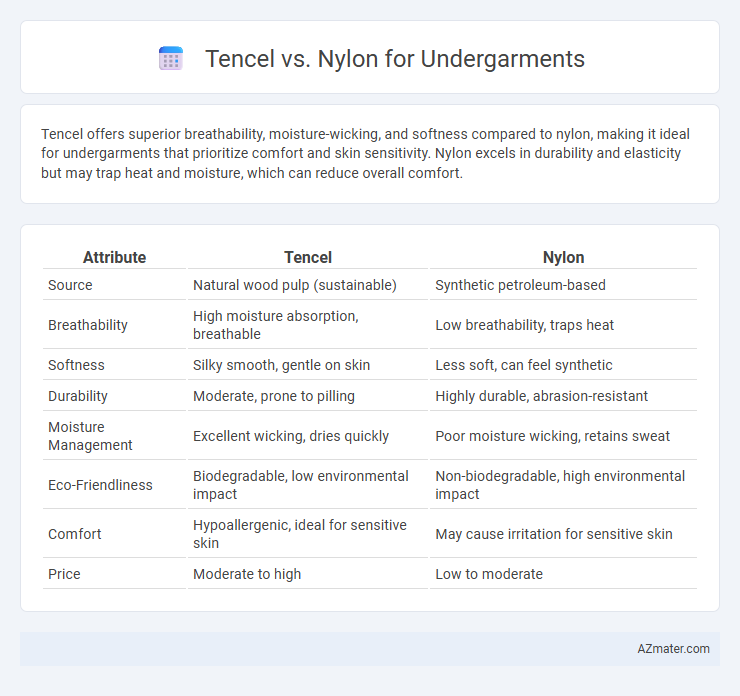Tencel offers superior breathability, moisture-wicking, and softness compared to nylon, making it ideal for undergarments that prioritize comfort and skin sensitivity. Nylon excels in durability and elasticity but may trap heat and moisture, which can reduce overall comfort.
Table of Comparison
| Attribute | Tencel | Nylon |
|---|---|---|
| Source | Natural wood pulp (sustainable) | Synthetic petroleum-based |
| Breathability | High moisture absorption, breathable | Low breathability, traps heat |
| Softness | Silky smooth, gentle on skin | Less soft, can feel synthetic |
| Durability | Moderate, prone to pilling | Highly durable, abrasion-resistant |
| Moisture Management | Excellent wicking, dries quickly | Poor moisture wicking, retains sweat |
| Eco-Friendliness | Biodegradable, low environmental impact | Non-biodegradable, high environmental impact |
| Comfort | Hypoallergenic, ideal for sensitive skin | May cause irritation for sensitive skin |
| Price | Moderate to high | Low to moderate |
Introduction to Tencel and Nylon Fabrics
Tencel, made from sustainably sourced wood pulp, is a biodegradable fabric known for its breathability, moisture-wicking properties, and softness, making it ideal for sensitive skin in undergarments. Nylon, a synthetic polymer, offers high durability, elasticity, and resistance to abrasion but may lack breathability compared to natural fibers. Understanding the distinct moisture management and comfort features of Tencel versus the strength and stretch of Nylon is essential when selecting fabrics for undergarment performance and comfort.
Key Differences Between Tencel and Nylon
Tencel, a sustainable fiber derived from wood pulp, offers superior breathability, moisture-wicking properties, and softness compared to nylon, which is a synthetic fiber known for durability and elasticity. Nylon provides higher resistance to abrasion and stretch, making it more resilient for activewear, whereas Tencel excels in comfort and skin-friendliness due to its natural fibers and biodegradability. The key differences between Tencel and nylon lie in their environmental impact, tactile feel, and moisture management, with Tencel being eco-friendly and biodegradable while nylon is petroleum-based and less breathable.
Comfort and Softness Comparison
Tencel fibers provide exceptional breathability and moisture-wicking properties, making undergarments feel soft, smooth, and cool against the skin. Nylon offers durability and elasticity but tends to trap heat and moisture, which can reduce overall comfort during extended wear. The natural cellulose composition of Tencel results in a gentle touch and hypoallergenic qualities, outperforming nylon in softness and skin sensitivity.
Breathability and Moisture-Wicking Properties
Tencel fibers offer superior breathability and moisture-wicking properties compared to nylon, making them ideal for undergarments that require high comfort and temperature regulation. Tencel's natural cellulose structure absorbs moisture efficiently and releases it quickly, keeping the skin dry and cool during prolonged wear. Nylon, while durable and quick-drying, tends to trap heat and moisture, potentially causing discomfort in sensitive undergarment applications.
Durability and Longevity of Tencel vs Nylon
Tencel fibers offer excellent durability due to their high tensile strength and natural resistance to wear, ensuring long-lasting undergarment performance while maintaining softness. Nylon, a synthetic polymer, provides exceptional durability and abrasion resistance that often surpasses natural fibers, contributing to extended garment lifespan under frequent washing and use. Compared to nylon, Tencel's biodegradability and moisture management capabilities enhance comfort but may require more delicate care to maximize longevity.
Skin Sensitivity and Hypoallergenic Features
Tencel fabric is highly favored for undergarments due to its natural moisture-wicking properties and hypoallergenic benefits, making it suitable for sensitive skin by reducing irritation and bacterial growth. Nylon, while durable and elastic, may trap heat and moisture, increasing the risk of skin irritation and allergic reactions in individuals prone to sensitivity. Choosing Tencel over nylon enhances comfort and skin health, especially for those with eczema or sensitive skin conditions.
Environmental Impact and Sustainability
Tencel, derived from sustainably harvested eucalyptus trees through a closed-loop process, offers a lower environmental impact compared to nylon, which is petroleum-based and contributes significantly to microplastic pollution. The biodegradability of Tencel enhances its sustainability profile, whereas nylon persists in ecosystems for decades. Choosing Tencel undergarments supports reduced carbon emissions, water conservation, and less chemical use, aligning with eco-friendly and sustainable fashion choices.
Care and Maintenance Tips
Tencel undergarments require gentle washing in cold water with mild detergent to maintain their moisture-wicking and softness properties, while avoiding bleach and fabric softeners preserves fabric integrity. Nylon undergarments benefit from hand washing or delicate machine cycles, using cool water to prevent damage and retain elasticity, with air drying recommended to avoid heat-related weakening. Both materials should be stored in breathable conditions, ensuring longevity and comfort by minimizing exposure to harsh chemicals and excessive heat.
Cost and Affordability Analysis
Tencel undergarments typically cost more than nylon due to their sustainable production process and premium fiber quality, which drives up retail prices. Nylon offers a more affordable option with widespread availability, making it popular for budget-conscious consumers seeking durability and moisture-wicking properties. Cost analysis shows nylon garments often yield better price-per-wear value, while Tencel appeals to niche markets valuing eco-friendly material despite higher upfront costs.
Final Verdict: Which Is Better for Undergarments?
Tencel outperforms nylon for undergarments due to its superior breathability, moisture-wicking properties, and natural softness, which enhance comfort and reduce skin irritation. Nylon offers durability and elasticity, making it suitable for activewear but can trap heat and cause sweat buildup. For everyday wear, Tencel's eco-friendly production and comfort benefits make it the better choice for undergarments.

Infographic: Tencel vs Nylon for Undergarment
 azmater.com
azmater.com